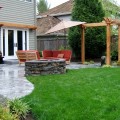Landscape Pathways
Pathways are both object and metaphor within a landscape design. Functionally, they are the way in—into the landscape, the house, the property. Visually, they lead the eye in, through, across and around the space. There’s no way around it: pathways make a statement.
“Pathways can have a big impact on the landscape and the experience one perceives as they transition through the garden and landscape or from the street to the home,” explains Jeff Halper, landscape design specialist with Exterior Worlds. “As an approach to a home, they tend to be the first insight into one’s personality.”
Your Landscape Design Questions
As you think about how best to use pathways in your landscape, you want to remember that, without a defined corridor into an area, you are less likely to use that area. This two-edged aspect means you can use paths to direct traffic to the areas you want to highlight and away from the ones you don’t. You also want the materials that make up the passageway to complement your home’s architecture. For instance, flagstone stepping stones work well with contemporary landscapes while brick paths enhance a formal landscapes.
Other questions to consider:
How do I connect the house to the yards and garden areas? A straight path is the most functional one and encourages foot traffic to keep moving, while the curvilinear path encourages the walker meander and tarry.
How do I add variety, excitement and interest to the garden? You can do this with the line of the path, the materials used to construct the pathway or the plantings along the way.
How do I interlink the different spaces of the landscape design—the outdoor kitchen, the swimming pool, and other hardscapes, like gazebos and arbors?
Material Matters
You have a wide range of materials to choose from and they include concrete, stone, pavers, gravels, brick, wood, mulch, stepping stones, grass and combinations of these elements. Your decision should be guided by the level of maintenance you are willing to incur. For instance, if you go with grass, it will need to be regularly cut and trimmed. Gravel needs to be raked and periodically refilled. Even concrete, one of the most durable choices, needs to be patched and cleaned from time to time.
Another consideration with your building material choice is to coordinate it with any garden theme. As an example, if you have a small garden sign, perhaps grass introduces some necessary greenery into your design. For classic landscape designs, gravel works well, as exemplified by the Tuileries Garden in Paris.
Add Drama
Paths and walkways are ready made for dramatic landscape lighting. Memorable gardens, both commercial and residential, can come alive after dark with it. Landscape lighting creates an enchanting interplay of light in professionally landscaped yard. It is not only a matter of how to light. Often it is as important to know what not to light as what to highlight. These decisions turn the nighttime landscape into a true work of art. Landscape lighting also adds a measure of safety, guarding against slipping and tripping along the darkened walkways.
If new pathways are part of your landscape plans, call Exterior Worlds at 713-827-2255. We have been providing high-end residential landscape services and garden design services for Houston and the surrounding areas, including the Memorial Villages, Tanglewood, River Oaks, Bellaire and West University, since 1987.

